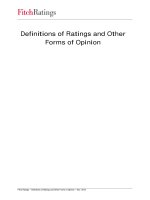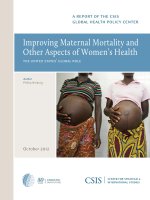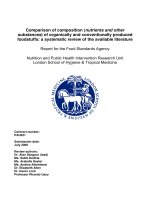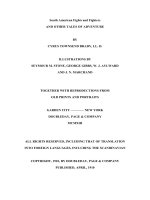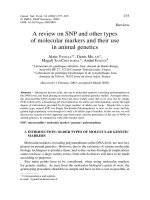Focused and unfocused written corrective feedback on tenses and other types of errors
Bạn đang xem bản rút gọn của tài liệu. Xem và tải ngay bản đầy đủ của tài liệu tại đây (944.2 KB, 95 trang )
FOCUSED AND UNFOCUSED WRITTEN CORRECTIVE
FEEDBACK ON TENSES AND OTHER TYPES OF ERRORS
NATTADAPORN LERTCHEVA
(M. A.), CHULALONGKORN UNIVERSITY
A THESIS SUBMITTED
FOR THE DEGREE OF MASTER OF ARTS
DEPARTMENT OF ENGLISH LANGUAGE AND
LITERATURE
NATIONAL UNIVERSITY OF SINGAPORE
2014
DECLARATION
I hereby declare that this thesis is my original work and it has been
written by me in its entirety.
I have duly acknowledged all the sources of information which
have been used in the thesis.
This thesis has also not been submitted for any degree in any
university previously.
________________________
NATTADAPORN LERTCHEVA
30 APRIL 2014
Abstract
This research study investigated whether written corrective feedback is
effective on L2 learners’ writing. It examined learners' noticing of corrected
errors and their acquisition of tense and other linguistic forms (articles,
spelling, pronouns, vocabulary usage and preposition errors). Nine EFL
learners from Potisarn Pittayakorn School, a government secondary school
located in Bangkok, Thailand participated in this study and composed four
essays and performed thought-aloud protocol when going through their
corrective feedback. Results obtained from the first essay show that the
learners in the no feedback group performed better in terms of tense and other
types of linguistic forms, followed by the focused feedback group and the
unfocused feedback group. In the revised draft, the learners in the focused
feedback group did better in tense in comparison to the unfocused feedback
group and no feedback groups. In contrast, in the revised draft the learners in
the unfocused feedback group did better in other types linguistic forms in
comparison to the focused feedback group and no feedback groups. The posttest results show that there were marginal differences in the effects on
acquisition on tense and other types of linguistic forms between the focused
and unfocused feedback groups, but the delayed post-test results show that
unfocused feedback compared to the focused feedback group actually yielded
better long-term acquisition effects.
Acknowledgement
I would like to express my sincere thanks to my supervisor, Dr. Justina Ong,
Department of English Language and Literature, NUS, for her patience, care
and guidance shown in completing this research thesis. I thank her for being
supportive and understanding and for her advice. In addition, I would also like
to express my sincere gratitude to the examiners who spend their time reading
my thesis and giving me valuable feedback.
Table of Contents
List of Tables ........................................................................................... iii
List of Figures ........................................................................................... iv
List of Abbreviations ................................................................................. v
Chapter One: Introduction ................................................................................. 1
1.1
Overview – Written Corrective Feedback .......................................... 1
1.2
Problems Faced in Corrective Feedback Studies ................................ 3
1.3
Focus of Current Study ....................................................................... 4
1.4
Significance of Current Study............................................................. 5
1.5
Types of Corrective Feedback Used in the Present Research............. 6
Chapter Two: Literature Review ....................................................................... 7
2.1.1 Categories of Corrective Feedback Research ................................... 11
2.1.2 Types of Written Corrective Feedback ............................................. 12
2.1.3 Prior Work on Focused and Unfocused Feedback ............................ 17
2.1.4 Critiques on Previous Research ........................................................ 20
2.2
Defining Noticing ............................................................................. 22
2.2.1 Previous Research on Noticing ......................................................... 23
2.3
Think-Aloud Protocol ....................................................................... 25
Chapter Three: Research Methodology ........................................................... 27
3.1
Context of the Study ......................................................................... 27
3.2
Participants ........................................................................................ 27
i
3.3
Research Design................................................................................ 28
3.4
Procedure of the Study ...................................................................... 29
3.5
Training for Think Aloud.................................................................. 33
3.6
Rating of Essays ................................................................................ 34
3.7
Data Analysis .................................................................................... 36
Chapter Four: Results ...................................................................................... 41
4.1
First Research Questions................................................................... 41
4.2
Second Research Question ................................................................ 48
4.3
Third Research Question................................................................... 54
Chapter Five: Conclusion ................................................................................ 61
References ........................................................................................................ 64
Appendix I: Example of Focused and Unfocused Feedback ....................... 72
Appendix II: Transcription for Think-aloud ................................................ 75
ii
List of Tables
Table 1.1: Types of written corrective feedback…………………………… 6
Table 2.1: Examples of research on different feedback types……………… 12
Table 3.1: Percentage of errors noticed by the learners (a sample only) ….. 37
Table 3.2: Errors in first and second drafts (a sample only)……………..… 39
Table 3.3: Percentage of errors in first and second drafts (a sample only).... 39
Table 3.4: Errors in first drafts, post-test and delayed post-test
(a sample only)…………………………………………………...40
Table 3.5: Percentage of errors in first draft, post-test and delayed
post-test (a sample only)……………………............................... 40
Table 4.1: Percentage of errors noticed by the learners……………………. 46
Table 4.2: Errors in first and second drafts ……………...……………….. 48
Table 4.3: Percentage of errors in first and second drafts ………………... 49
Table 4.4: Errors in first draft, post-test and delayed post-test ………….
54
Table 4.5: Percentage of errors in first draft, post-test and
delayed post-test ………………………………………………... 55
iii
List of Figures
Figure 2.1: Prediction of the relationship between input,
intake, and learning …………………………………………... 24
Figure 3.1: A five-stage task workflow …………………………………… 29
Figure 3.2: Focused feedback ………………………….………………….. 31
Figure 3.3: Unfocused feedback …………………………………………... 31
Figure 3.4: No feedback …………………………………………………… 31
Figure 4.1: Corrected sentences spoken aloud by the learners ……………. 42
Figure 4.2: Original sentences with meta-linguistics feedback spoken
aloud by the learners …………………………………………... 43
Figure 4.3: Original sentence reflecting no noticing ……………………….44
Figure 4.4: Transcriptions which the learners question whether the
original writing was correct or wrong ………………………… 45
Figure 4.5: Percentage of tense error in first and second drafts …………. 50
Figure 4.6: Percentage of other types of error in first and second drafts … 51
Figure 4.7: Percentage of all types of errors made in first and
second drafts ………………………………………………… 52
Figure 4.8: Tense error in first draft, post-test and delayed post-test ……... 57
Figure 4.9: Other errors in first draft, post-test and delayed post-test ……. 58
Figure 4.10: Total errors in first draft, post-test and delayed post-test ……. 59
iv
List of Abbreviations
EFL: English-as-a-Foreign-Language
EP:
English Program
GP:
General Program
IEP:
Intensive English Program
L2:
Second Language
VPA: Verbal Protocol Analysis
v
Chapter One: Introduction
1.1 Overview – Written Corrective Feedback
Research on second language (L2) writing is divided into five major areas: (1)
L2 writers’ characteristics, (2) L2 writing process, (3) L2 writing feedback, (4)
L2 writing instruction, and (5) L2 writers’ texts (Archibald & Jeffery, 2000;
Zhang, 2008). Various studies have flourished under these five areas, and they
all share a main objective of improving writing skills of L2 writers. The results
from studies dealing with L2 writing feedback and more specifically written
corrective feedback, have been rather inconclusive in whether corrective
feedback does assist in learners’ L2 writing. Among the types of corrective
feedback that have been studied are direct corrective feedback, indirect
corrective feedback, meta-linguistic corrective feedback and the focus of the
feedback (Ellis, 2008). Each type has been found to contribute in different
ways and in varying degrees to learners’ writing. Both positive and negative
findings were obtained from these studies. Some research findings suggest that
written corrective feedback is ineffective in helping L2 learners to improve
their writing (e.g. Kepner, 1991; Polio, Fleck & Leder, 1998), whereas other
studies found written corrective feedback to be effective in improving L2
writing (e.g. Ellis, Sheen, Murakami & Takashima, 2008; Bitchener & Knoch,
2009; Binglan & Jia, 2010; Van Beuningen, De Jong & Kuiken, 2012).
Following this lack of consistent results, this study has been conducted to
examine the effects of written corrective feedback. A major study that created
waves in the L2 writing community was Truscott’s work (1996). Truscott
(1996) claimed that grammar correction was ineffective in improving learners’
writing. He proposed theoretical and practical arguments to explain why
1
grammar correction was ineffective. His work then paved the way for more
research with results that countered (Sheen, 2007; Bitchener, 2008; Bitchener
& Knoch, 2009) as well as supported (Polio, Fleck & Leder, 1998) his
findings.
The present work aims to study the effect of focused and unfocused written
corrective feedback on Thai English as a Foreign Language (EFL) learner.
Focused feedback refers to feedback that is given only on a specific and preselected error. For example, feedback provided only on errors displaying
incorrect use of English articles (see Sheen, 2007) is an example of focused
feedback. As Thai learners often display tense errors in language production
(Pongsiriwet, 2001; Srichangyachon, 2011), the focused feedback aspect of
this study was tense errors. Unfocused feedback refers to feedback that is
given on all or a range of error types. For unfocused feedback, I corrected
tense, articles, spelling, pronouns, vocabulary usage, and preposition errors.
Both focused and unfocused feedback were given to the learners in a direct
corrective feedback format together with meta-linguistic explanations. Direct
corrective feedback refers to providing learners with the correct target
language form when they make an error (Ellis, Sheen, Murakami & Takashimi,
2008). To provide direct corrective feedback, every error was underlined and
its correct form was indicated above it. Written meta-linguistic feedback was
also provided in the form of rules regarding each type of error. Sheen (2007)
found that there was no significant difference between the effect of direct and
indirect feedback. She also found that direct corrective feedback was more
effective when accompanied with meta-linguistic explanations than without
them (Sheen, 2007).
2
1.2 Problems Faced in Corrective Feedback Studies
Despite the numerous studies on corrective feedback in L2 writing, their
results have largely been inconclusive in showing whether corrective feedback
is indeed effective and useful. Thus, there is clearly room for further research
in finding out if corrective feedback is truly effective.
In order to know whether giving corrective feedback is effective, it is
necessary to conduct studies that use corrective feedback as well as those
without. Although there have been studies comparing the effects of the
different methods of grammar correction, Ferris (2004) has pointed out that
there were only a handful of studies that compared the accuracy of language
produced by L2 learners who received grammar correction against those who
did not. A major contributing factor to this is the dilemma faced by teachers.
Many teachers feel that it is unethical to withhold feedback from their learners
for research purposes. Teachers withhold feedback only when they feel that
correcting the error is of no benefit to the learners. There are also teachers and
researchers who feel that providing written corrective feedback may instead
make learners lose confidence in their writing abilities.
Another problem with corrective feedback research is that there are many
research studies which focus on a single type of error (focused feedback) (e.g.
Bitchener & Knoch, 2009b; Sheen, 2007) – instead of a number of errors
(unfocused feedback). Focused, as opposed to unfocused, feedback is limited
and its findings also reflect a limited aspect of L2 writing ability.
Finally, there is a shortage of qualitative studies. According to Van Beuningen
(2010), most research related to grammar correction focused on group
3
performances by analysing errors per 100 words. This quantitative approach
has proven useful but it fails to contribute much to the understanding of how
an individual learner performs. In other words, quantitative approach cannot
describe the process-oriented nature of learning in detail.
1.3 Focus of Current Study
This study investigates whether written corrective feedback is effective in
improving Thai learners’ L2 writing in terms of tense and other linguistic
forms. Both focused and unfocused feedback are employed in this study. This
study also looks into the instances of noticing to achieve a more meaningful
understanding of how learners process the errors. In addition, the short and
long term effects of focused and unfocused written corrective feedback are
also investigated.
Both qualitative and quantitative approaches are employed in this study.
Qualitatively, it investigates the role of (individual) learner’s noticing and the
relationship between noticing and the acquisition of linguistic forms. Its
quantitative aspect looks at the number of noticing instances in relation to
corrective feedback.
Nine Thai secondary school learners are asked to compose four essays and
think-aloud while reading the corrected errors.
The following research questions are addressed in this study:
i.
What do the think-aloud protocols produced by the learners show about
the learners’ noticing of errors?
ii.
What types of feedback help the learners improve their writing?
4
• Focused meta-linguistic corrective feedback
• Unfocused meta-linguistic corrective feedback
• No feedback
iii.
What types of feedback (focused or unfocused with meta-linguistics)
lead to the learners’ acquisition of tenses and other linguistic form in
writing?
1.4 Significance of Current Study
Unlike most other studies on written corrective feedback which looked at
article errors (e.g. Sheen, 2007, 2010; Ellis, Sheen, Murakami & Takashimi,
2008; Bitchener & Knoch, 2009), this study focuses on tense errors. This will
help expand the scope of corrective feedback research covering this rather
neglected area. The selection of this aspect of L2 writing would be particularly
useful to learners and teachers in Thailand where tense in English has been
found to be a major problem among L2 learners. This study aims to provide
some insight into a relatively under-studied and key area of written corrective
feedback.
In addition, the task work flow in this study is designed to be conducted in a
out-of-classroom setting, setting it apart from most prior work on written
corrective feedback which have been typically conducted in classrooms. This
is to eliminate the possible effects of the in-classroom context, such as
heightened attention focus and performance pressure. For example, if this
study is conducted in the classroom, the learners might have paid more
attention to the feedback because of the motivation to perform well in class.
5
1.5 Types of Corrective Feedback Used in the Present Research
A central aim of this research is to investigate the effects of focused and
unfocused written corrective feedback. Table 1.1 shows a summary of the
types of corrective feedback used in this study.
1
Types of written
corrective feedback
Direct corrective feedback
Reasons for use
2
Meta-linguistic corrective feedback
•
•
•
3
Focused and Unfocused Feedback
•
•
•
•
•
•
•
4
No feedback
•
Easy to carry out
Less time consuming
Produces accurate revisions
Provides correct target form to
learners
Stimulates learners’ explicit knowledge
Assists learners in understanding errors
Explicit
instructions
assist
L2
acquisition
Focused feedback focuses on specific
errors
Unfocused feedback focuses on a range
of errors
Teachers decide whether to focus on
specific error types, or all errors
Used to investigate if written
corrective feedback is effective. The
assumption is if corrective feedback is
useful, then learners who do not
receive any should perform poorly
compared to those who receive it.
Table 1.1: Types of written corrective feedback
6
Chapter Two: Literature Review
The study of written corrective feedback has been much studied and debated
since Truscott (1996) raised an issue on written grammar correction. However,
despite the significant amount of research activity, there remains no
conclusive result on whether written corrective feedback is actually effective
for language learning.
This present study was designed and executed in
response to this lack of conclusive result, particularly in relation to the
effectiveness of written corrective feedback (focused, unfocused, and no
feedback).
In this chapter, an overview of different types of corrective feedback is first
presented. This is followed by a review of the different types of corrective
feedback related to the current study. Briefly, these categories are direct
corrective feedback, indirect corrective feedback, meta-linguistic corrective
feedback, focused and unfocused feedback, and implicit and explicit feedback.
In the second section, previous research related to these five areas is also
reviewed and critiqued. The nature and effect of noticing is also discussed as
this hypothesis is related to the current study which focused on whether
noticing has an effect on learning. Overview of Corrective Feedback
The central claim of Truscott’s (1996) controversial yet landmark research is
that grammar correction is ineffective in improving learners’ writing. In this
work he also proposed reasons for this ineffectiveness. The theoretical and
practical problems identified in his research can be summarized as follows;
7
(I) Theoretical Problems
(a) The Problem with Acquisition
Truscott (1996) argued that a simple information transfer through written
corrective feedback cannot be effective in the acquisition of knowledge. He
further argued that a single form of correction is unlikely to be of use to
learners learning the entire range of linguistic forms and structures. This is
because an understanding towards a particular form alone is syntactically,
lexically, and morphologically inadequate; one has to understand the meaning
along with its usage of the form in relation to other words and other parts of
the language system. The lexicon is not only about words; it relates to the
meaning, form and usage of each word and it is dependent on the relationship
between words and phrases in the language system. This applies to
morphological knowledge as well. These lexical and morphological
complexities are more subtle than mere exposure of a single linguistic form,
but are necessary to the process of acquisition by learners. As such, in order to
be effective, correction must be done to address these learning processes
instead of simply employing a ‘transfer mode’ of information to the learners.
(b) Order of Acquisition Problem:
Truscott raised a second theoretical argument against the effectiveness of
written corrective feedback on L2 acquisition. The argument addresses the
question on whether the learners to whom the written corrective feedback has
been provided for align well with the learners’ developmental stage. In simple
terms, it is about how prepared the learners are in learning. According to L2
acquisition theory, the learning of linguistic form and structures would follow
8
a certain natural order where the L2 learners are trained through a series of
predictable stages in their quest to acquire linguistic features. When written
corrective feedback is given at the point of time which is inconsistent with this
natural order, written corrective feedback may not be effective in helping
learners to learn. Thus, selective grammar corrections by the teacher should be
done with respect to the individual learners’ grammar development level.
(c) Pseudo-Learning Problem:
Truscott also postulated that even if there were any possible learning from
written corrective feedback, this might be likely due to pseudo-learning.
Learning in this manner meant that learners would forget the “acquired
knowledge” within a few months. It is important that both researchers and
language instructors pay attention to the types of learning acquired by learners
instead of just concentrating on whether learners improve their writing
proficiency.
The above three theoretical problems raised by Truscott have been strongly
resisted by some researchers. Bitchener & Knoch (2009) highlighted that there
were sufficient studies to conclude that written corrective feedback is effective
and in some studies (e.g., Sheen, 2007; Bitchener, Young & Cameron, 2005;
Bitchener, 2008), learners were able to display the acquisition of knowledge in
their writing from the given feedback on the targeted language after at least a
6-month period. Bitchener (2008) showed that written corrective feedback is
useful in helping learners acquire simple, rule-governed forms and structures,
such as the English article system and the past simple tense. In addition, from
the oral corrective feedback studies (see Mackey & Philp, 1998; Mackey &
Oliver, 2002), it was found that emphasizing single error category correction
9
produced positive results. In addition, Bitchener & Knoch (2009) reported that
there are a number of research studies showing that English-as-a-SecondLanguage writers utilised the written corrective feedback they received from
previous essays while writing their new essays. These studies demonstrated
that written corrective feedback truly improves learners’ writing proficiency
and it did not result in pseudo-learning, as had been claimed by Truscott
(1996).
(II) Practical Problems
(a) Problem from Teachers:
In written corrective feedback, errors are to be first identified by teachers. This
process of identification is not without problems. Cohen & Cavalcanti (1990)
observed that in many instances, teachers were unable to notice errors. Even if
errors were spotted by the teachers, it might not mean that the teachers have
understood its correct usage.
(b) Problem from Learners:
Learners may not understand the explanations provided to them through
written corrective feedback. This failure to understand could be due to a
variety of reasons including the teacher’s lack of understanding on the cause
of an error committed by the learners, and this could be miscommunicated to
the learners through wrong meta-linguistic explanations. Although learners
can rewrite an essay after reading the given feedback, they may not understand
the explanations and it is likely that they would make the same error again.
Even if learners understood the feedback, they are prone to forgetting the
newly-acquired knowledge relatively fast. This is even more so if the error
10
explanation is complex - it will be even harder for learners to remember and
understand their errors. Consequently, these learners would not be motivated
to correct their writing according to the feedback they received. Based on the
theoretical and practical problems discussed above, Truscott (1996)
summarised that corrective feedback was not only ineffective but also
unnecessarily provided for L2 learners. However, Ferris (2004) mentioned that
the conclusion of Truscott on L2 writing was neither complete nor conclusive
enough to show that grammar correction was ineffective because Truscott had
overlooked or simply understated the positive evidence obtained from the
many research studies investigating the effectiveness of grammar correction.
In the following section, categories of corrective feedback research which
suggested by Ferris (2012), are discussed.
2.1.1 Categories of Corrective Feedback Research
The first category is the “Study of Text Analytic Description of Learner Errors
and Teacher Feedback”, where descriptive works of several types of errors
are emphasised. It comprises the analysis of a relatively large-sized collection
of learners’ texts and learners’ errors. These errors or corrections were
identified, counted and further categorised. The types and quantity of each
type of error made by the learners over a period of time were identified and
how the teachers marked the errors were recorded in a chronicle order.
The second category is “Study on the Effects of Written Corrective Feedback
in L2 Writing”. This includes the most influential and recent empirical work
on written corrective feedback. Studies carried out in this category include
controlled quasi-experiments conducted by L2 acquisition researchers and
11
longitudinal classroom-based studies by scholars in the field of foreign
language and L2 writing. Research conducted includes those studying the
short term and long term effects of written corrective feedback. The effects of
different types of written corrective feedback, such as direct feedback vs.
indirect feedback, unfocused feedback vs. focused feedback, have also been
studied.
The third category is “Study on the views of the Teacher and Learner on
Written Corrective Feedback”. As the name suggests, studies under this
category would be those that examine the various aspects of teacher-learner
opinions with regards to the written corrective feedback.
2.1.2 Types of Written Corrective Feedback
The studies of the corrective feedback vary in the type of feedback as shown
in Table 2.1.
S/N
1
2
3
Researchers
Bitchener, Young & Cameron
(2005)
Ellis, Sheen, Murakami &
Takashimi (2008)
Bitchener & Knoch (2009)
Type of Feedback
Direct, explicit written feedback
Focused and unfocused feedback
Direct corrective feedback and meta-linguistic
explanation
Table 2.1: Examples of research on different feedback types
They are direct corrective feedback, indirect corrective feedback, metalinguistic corrective feedback, focused and unfocused feedback, electronic
feedback and reformulation. Of these, only direct, indirect, meta-linguistic,
focused and unfocused corrective feedback are related to the present study and
reviewed here. Another type of written corrective feedback – implicit and
12
explicit feedback – is also included as they have an important role in the
learning process.
(1) Direct Corrective Feedback
Direct corrective feedback refers to providing learners with the correct target
language form when they make an error (Ellis, Sheen, Murakami & Takashimi,
2008). These corrections can be in various forms such as by striking out or
cancelling unnecessary morphemes, words or phrases, by adding missing
morphemes or words, and also by writing out the corrected form near to or
above the erroneous form.
The explicit guidance provided through direct corrective feedback is
advantageous to learners as it helps and guides them in correcting their errors,
especially in cases where the learners are unsure and not capable of selfcorrecting these errors. Direct corrective feedback may be better than indirect
feedback for writers with lower proficiency level, as described in the work of
Ferris & Roberts (as cited in Ellis, 2008 p. 99).
The errors being explicitly highlighted and marked out by teachers also means
that very little processing is required from learners. This relatively teachercentric feedback method may not lead to long term learning as the learners do
not need to think or analyse how to correct their errors.
(2) Indirect Corrective Feedback
Indirect corrective feedback describes the kinds of strategies or methods that
prompt learners to self-correct their errors (Ellis, Sheen, Murakami &
Takashimi, 2008). When giving indirect corrective feedback, teachers indicate
13
which linguistic forms contain errors but they do not provide the correct forms
of these errors. For example, a written corrective feedback of this type can be
in the form of highlighting or underlining the error made, or marking a cross
or other symbols along the margin where the line containing the error was
made. In turn, the learners receiving these indictors or prompts interpret them
and figure out what their correct forms are.
Indirect feedback in written corrective feedback thus requires more mental
processing by learners who need to figure out what could have ‘gone wrong’
with that part of their writing – a process not unlike problem-solving. This also
makes it more likely for learners to remember the errors which would be more
effective for longer term learning compared to direct corrective feedback.
(3) Meta-linguistic Corrective Feedback
When teachers provide written, explicit comments on student errors, this form
of feedback is known as meta-linguistic feedback. These comments can take
the form of error codes or explanations of the errors. Error codes are made up
of abbreviated codes for various kinds of errors committed. For example, a
teacher may write the code “art.” to indicate that there is an error related to the
use of articles. These codes are usually marked along the margin or at the
location where the error was made. In the case where the codes are marked
along the margin, the learners would have to first locate the error made and
revise the word or phrase accordingly. If the codes are marked at the error
location, the learners would just need to make the necessary correction at the
same location, without having to locate the error.
14
A major problem in providing meta-linguistic feedback is how well-designed
or comprehensive the error code categories are. To illustrate with English,
would a single category for the use of articles be more desirable, or would two
separate categories for indefinite articles and definite articles be more suitable
for learners?
Providing meta-linguistic explanations to errors is less commonly practiced
among L2 teachers mainly because it consumes more time than indicating
error codes as feedback. Another deterrence to applying this approach in
language teaching is the need for teachers to provide explanations in the form
of linguistic generalizations or rules. This necessitates a high level of
competence in meta-linguistic knowledge among teachers before error
explanations I will can be presented clearly and accurately to learners. Where
teacher knowledge is insufficient, these meta-linguistic explanations may end
up confusing learners instead.
(4) Focused and Unfocused Feedback
Feedback given to learners can be described as being focused or unfocused.
Unfocused feedback refers to the correction of all or a range of errors in
learners’ written texts. This extensive manner of correction is one that is
typically used by language teachers. In contrast, focused feedback refers to the
selection of only specific errors to be corrected in learners’ written texts (Ellis,
Sheen, Murakami & Takashima, 2008).
The teachers may choose to provide feedback to all the errors committed by
learners, but such corrective feedback would be obscured and not focused, at
15
the same time diffusing the learners’ attention to various errors at one time. A
method to ensure that feedback is done more effectively is by having teachers
choose specific types of error targeted for correction. Being exposed to various
types of errors at one session may mean that learners would not be able to
concentrate much on each error type. Therefore, it seems fairly intuitive that
focused corrective feedback is more efficient in enhancing learners’
proficiency as the learners would be able to analyze the possibility of multiple
corrections associated with a single error, which in turn helps them to better
understand this error and its correct forms.
However, there could still be significant value in unfocused corrective
feedback, namely it may help learners to have a broader view of what their
weaknesses are. Language does, after all, appear in context and not discrete
sequences of technical elements. At times, errors committed may be dependent
on other errors in context, or they could be of a mixed error types (for example,
a word with vocabulary error which also reflects wrong article usage).
Highlighting solely on a single error category may miss out on certain
potential benefits of a more holistic approach to language and feedback.
(5) Implicit and Explicit feedback
Implicit feedback has been described (Ellis, Loewen & Erlam, 2006) as having
no indicators to show where errors are, while in explicit feedback, indicators
are used to show where the errors are. Explicit feedback can come in two
forms. The first form is explicit correction where teachers identify and tell
learners what the errors are along with their correct forms. The second form is
meta-linguistic in nature. Teachers will give comments, information and/or
16
